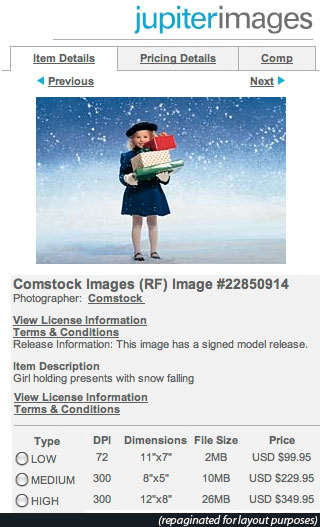Black Friday? Try, "You Get What You Pay For" Friday!
 I know I'm not seeing double. I am seeing stupidity and cheapskates in action.
I know I'm not seeing double. I am seeing stupidity and cheapskates in action.
An interesting set of ads arrived here at Photo Business News & Forum headquarters.
Syms, a place for discounted suits and so forth, and Guideposts, a Christian publication, both used this same image at the same time in their outreach. One to sell clothes, the other to sell salvation.
This isn't the first time one person has been used for different organizations at the same time. Both Dell and Gateway were using a young college-aged girl to sell back-to-school computers, as ASMP showed here.
(Continued, with Sym's and Guidepost use samples, after the Jump)
Syms, who's tagline is "where an educated consumer is our best customer", must be in need of some education about the risks of Royalty Free imagery. Specifically, from places like Jupiter Images, and inmagine.com. Both are selling this photo (at right), either as an individual RF sale, or, as one image on a CD of 104 images with a "Christmas" theme, for just under $500. The image, originally available through Comstock, is sold through Jupiter Images here, and Inmagine here.
What is laughable, of course, is that Inmagine's tagline for their site is "Imagine the Difference". Guess not only is there no difference between them and Jupiter, but also, no difference between the key image for both these marketing pieces.
Guidepost, who used the same image on their cover, sports the tagline "True Stories of Hope & Inspiration". For whom? Clearly not the creator of this image, who's only hoping you paid for this as a one-off license (not likely). This issue's headline is "Let Guideposts Lighten Your Load This Holiday Season!", or, perhaps try "Let Guideposts lighten this photographer's wallet with this issue!".
So, here's the Sym's postcard mailer:

And here's the Guidepost mailing:

In Jupiter Images' License Information, it says " JUPITERIMAGES requests the copyright notice “© [insert current year] JupiterImages Corporation” appear adjacent to the Image(s) or on a credit page."
A few clicks of the mouse found this image on both sites, with no problem, yet, neither use lists the requested photo credit. Oh well. However, Comstock (or the photographer) probably owns the copyright to this image, and thus, denoting as above would be a mis-statement.
No doubt the creator of these pieces had the Christmas RF disk sitting around, and they probably laid the design out, and billed the client for a stock photo, pocketing the profit, and nothing goes to the photographer. Once again, photographers get a lump of coal, and the ad agency or publication pockets the dough.
Please post your comments by clicking the link below. If you've got questions, please pose them in our Photo Business Forum Flickr Group Discussion Threads.

4 comments:
Hey John, I can't figure out if you're poking fun at the creator of the ad, the companies, licensing company, agency or photographer. The headline seems company focused.
Maybe the whole system?
I feel sorry for the photographer, who was probably paid by Comstock $100 for this photo, since that was a common model that they used to acquire images that they then put on RF discs, and that, after the $100 fee, the photographer wasn't generating a dime further from the images. This is likely the case since it lists Comstock as the photographer, and is also solicited as an image of an entire RF disc as an up-sell option.
Now, this high production cost image is being used extensively, and the creator isn't earning more money from his endeavor.
I am thus, within this paradigm, critical of Comstock and Jupiter for not sharing in the income, and further, contributing to the delinquency of a photographer by not doing so.
Further, I am mocking the companies who sought RF imagery as a way to save money for a signature use like this. Had they been more thoughtful and less stingy, they could have obtained a rights-managed image and sought exclusivity for the image during the term.
Or, in fact, they could have commissioned an image that was custom to their needs (maybe a package with Syms wrapping paper, or for the Guideposts use, a crucifix) which would have helped them differentiate themselves.
So, yes, I am being critical of most all of the elements of the system. I am not being critical of stock in general, but rather, how stingy choices leads to potential confusion in the eyes of the public.
Ok, just to keep the discussion going ...
Maybe the photographer was happy? Not all photographers want to handle the business side. Not saying this was the case, but in order to make further money the photographer has to make it their business of distributing his/her work. Most industries work on a pecking order. If you own more of the problem then you get more of the pie.
Is it really bad that both ads had the same images? Both ads had holiday words- and that doesn't seem to be a problem. I think the bigger problem is that the ads were not targeted to the right people *and* the designer did not do enough to make the ad 'speak' with authenticity. The image is not the brand.
If you are a photographer, imagine how much work it was to create this image. You need a studio. In NYC that's going to run you a minimul of $500 for the day and more likely about $1,000 for the day. If you own lights you may need an assistant to help transport them. Otherise you'll pay a rental fee at the studio.
You have hold a casting to find a cute little girl with the right personality. You need a hair stylist for her hair. You need a makeup artist. You need a fashion stylist to get the coat and hat and shoes and stockings. And don't forget the little things like a prop stylist to wrap the packages. Honestly, I could not wrap a package as neatly as this image requires.
Oh, and did I forget that you need to make SNOW??!!?
Next you have to pay everyone involved and perhaps provide breakfast and lunch on the day of the shoot. And you have to make sure the little girl's parents understand that she's not going to be getting any additional money even if they keep seeing this image on all sorts of ads and billboards.
When you consider all of those factors, you can see where the fee for using this image is just too low.
Post a Comment